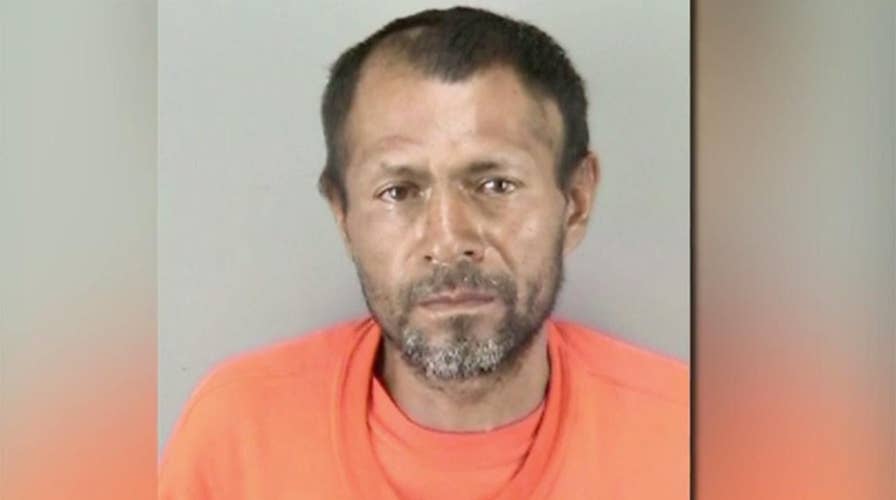Steinle verdict leads to calls for sanctuary city crackdown
Reaction on 'The Story' after illegal immigrant found not guilty of the murder of Kate Steinle.
The disturbing verdict in the killing of Kate Steinle – finding a criminal illegal alien not guilty of the most serious charges for her death – illustrates the need to find a way to end the “sanctuary cities” movement that has spread around the nation.
Steinle was only 32 when she was shot and killed in July 2015 by a bullet fired by illegal alien Jose Ines Garcia Garcia Zarate, who had a record of seven felony convictions and five previous deportations. Garcia Zarate did not deny shooting Steinle, but said it was an accident.
Garcia Zarate had been freed by San Francisco authorities three months before he shot Steinle, despite a federal immigration detention request to hold him so federal officials could take him into custody.
Now Garcia Zarate is, for the eighth time, a convicted felon – but he was found guilty Thursday of only illegal possession of a weapon. He was acquitted on the more serious charges of first- and second-degree murder, involuntary manslaughter and assault with a semi-automatic weapon.
Courtesy of American justice, Garcia Zarate had the full benefit of the due process of law conferred on American citizens – legal counsel at every step of the proceedings, an attentive judge, a jury of his peers, and the expectation that the government must prove its case beyond a reasonable doubt.
Steinle had none of those protections as she stood over the San Francisco Bay with her father, who would know her pleas for help as the last thing he’d ever hear her utter in a too-short life.
The case involving the young woman’s killing has spurred intense debate, Trump administration warnings to suspected sanctuary jurisdictions, lawsuits and proposed legislation on how U.S. immigration enforcement might proceed.
President Trump, Attorney General Jeff Sessions and the Department of Justice have weighed in, proposing dramatically different immigration enforcement schemes than their predecessors.
The political left has staked out its position on immigration. An estimated 300 jurisdictions large and small have sanctuary policies that work to defeat cooperation by local law enforcement with U.S. Immigrations and Customs Enforcement (ICE). The federal agency describes its mission as enforcing “federal laws governing border control, customs, trade and immigration to promote homeland security and public safety.”
The sanctuary jurisdictions create opportunities for further harm, just like that posed by Steinle’s killer. Their claim is that sanctuary cities are actually as safe as or safer than others, with illegal residents less likely to break the law and more likely to cooperate with law enforcement when real crimes occur.
And sanctuary jurisdictions argue that immigration enforcement is the province of the federal government and they have no desire or intention of acting as agents or holding facilities for the feds.
But sanctuary supporters conveniently ignore the fact that disregarding an ICE detainer request and setting an illegal alien criminal free creates a very real threat that the criminal will commit crimes harming innocent victims in the future.
Kate Steinle’s tragic case is but one in a sea of unnecessary tears.
Earlier this year, The Washington Times reported on a Center for Immigration Studies analysis that found that from January 1, 2014, to September 30, 2015, more than 17,000 ICE detainer requests were rejected by sanctuary jurisdictions.
Of those rejected requests, almost 70 percent were issued for individuals with a prior criminal history. That’s over 10,000 likely and confirmed criminal illegal aliens who ignored U.S. immigration law in how they came to be in this country, allegedly engaged in additional criminal conduct while here, and were returned to the streets rather than handed off to ICE.
This action, the left would have us believe, makes us safer rather than less safe. Over 10,000 times safer, if you follow the logic.
But there are holes in the logic. In reporting by the Boston Globe last year, the paper challenged statements by an Obama-era ICE director who was responsible for managing spin as the besieged agency itself released criminal illegal aliens inside U.S. borders.
In its review of recidivism by criminal illegal immigrants, the paper looked at 323 criminals released in New England from 2008 to 2012. It found as many as 30 percent committed new offenses, including rape, attempted murder and child molestation.
Last summer, police in Santa Rosa, California arrested 38-year-old Nery Israel Estrada-Margos for allegedly beating his girlfriend to death. Estrada-Margos had been in police custody before the murder for felony domestic battery charges after he allegedly beat his girlfriend following an argument.
Despite an ICE detainer request, police released Estrada-Margos from custody after he posted bail. Disingenuously claiming they tried to honor the ICE detainer request, the Sonoma County Sheriff’s Office released the suspected killer 16 minutes after notifying ICE, which was 60 miles away, of the pending release.
Veronica Cabrera Ramirez, Estrada-Margos’ girlfriend, didn’t have a voice in the sanctuary city debate. Her state is more interested in protecting people like Estrada-Margos from ICE than protecting her. It failed her and it is knowingly and intentionally failing others.
The stories of Kate Steinle and Veronica Cabrera Ramirez will fade with the passage of time. But theirs will simply be replaced by the stories of future victims of heinous and predictable crimes committed by criminal illegal aliens who take advantage of American kindness and weakness.
As we endure yet another “national conversation” – this one on border security and immigration – hundreds or perhaps thousands of new victims will fall prey to criminal illegal aliens upon whose intentions too many local jurisdictions and some states will place a losing bet.
In a Nov. 22 editorial, The Washington Post called Attorney General Sessions’ battle against sanctuary cities “pointless.” For Kate, Veronica and all those future victims of criminal illegal aliens, it’s anything but.

